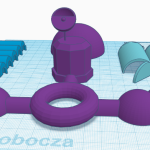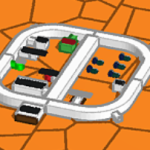Colonizing Ceres by Team Ceres
West Island College Calgary-Alberta Kanada 14 år gammal 3 / 3 Engelska Annan plats
Beskrivning av projektet
Skulle du kunna tänka dig att bo på Ceres? Ceres är en dvärgplanet som ligger i ett asteroidbälte mellan Mars och Jupiter. Tillsammans har vi kommit fram till en koloniseringsplan för Ceres.
Food and water: For food and water, we decided to use aquaponics to grow plants. Aquaponics is a food production system that couples aquaculture with hydroponics whereby the nutrient-rich aquaculture water is fed to hydroponically grown plants. For the fish, we’re using tilapia, since they produce a lot of waste. For the water, we’re going to use swarm robots with drills, since there is a ocean under the hard crust of Ceres. They will drill the water, and we are using a water distillation system to remove any excess salt, and then filtering it, then it will be safe to drink.
Air: The best way to do this would be by splitting water (H2O) into its two elements: hydrogen and oxygen. This is possible using a process known as electrolysis, which involves running a current through a water sample containing some soluble electrolyte. This process will require electricity. We would make a big electrolysis system, constantly monitored by scientists in the specialty. This should be an efficient way to produce oxygen when not using oxygen tanks. Supplies of oxygen would be distributed to different rooms.
Radiation: Ceres does experience some radiation from cosmic rays and solar radiation, but these levels are not particularly intense compared to some other celestial bodies. The lack of a substantial atmosphere means that Ceres doesn’t provide the same level of protection from cosmic rays and solar radiation as planets with thicker atmospheres, like Earth. So, we dont need to worry about the dangers of radiation.
Energy: To generate energy, we will build human sized hamster wheels and other gym equipment. The kinetic energy created by human movement will be stored and then used for electricity and heating. Each citizen of our camp will have workout schedules where they will be required to generate the energy. That way, everyone will be required to contribute to making energy. Protein and glucose rich food will be a part of the diet to maintain energy levels during sessions.
Gravity: The gravitational pull-on Ceres is very different that on Earth. While Ceres has a gravitational pull of 0.27 m/s², Earth has a gravitational pull of 9.807 m/s², so this would be a big problem for our bodies. So, our solution was to design special clothes with weights to mimic Earth’s gravitational pull. Since the gravitational pull of Ceres is 0.27 m/s², and Earth’s gravitational pull is 9.807 m/s², if you subtract Ceres’s gravitational pull from Earth’s gravitational pull, you will get your needed gravitational pull which is 9.537. Your bones also weaken, so we have a high intensity gym to maintain that strength
Projektlänk
https://www.canva.com/design/DAFznIqMDM4/h8Sc2ZBOsHjs1NUyWlfs1w/edit?utm_content=DAFznIqMDM4&utm_campaign=designshare&utm_medium=link2&utm_source=sharebutton
#3D-design
Andra projekt
Kluster av ekosystem på Mars - Base con ecosistemas en Marte















